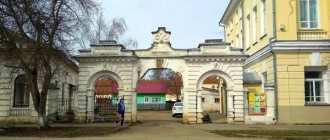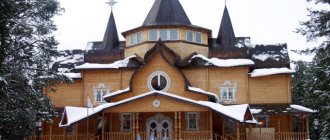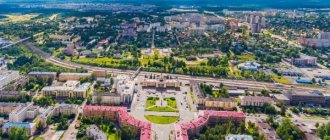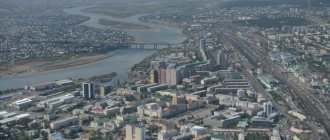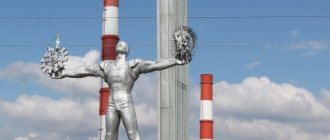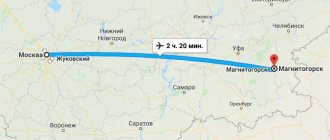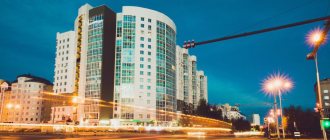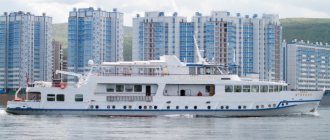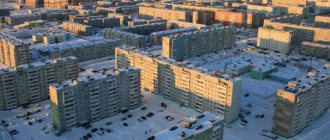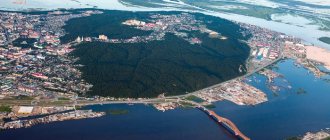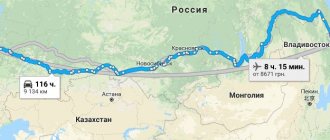Where is
The city is located in the northeastern European part of Russia, on the territory of the Vologda region. Veliky Ustyug is located on the left bank of the river. Sukhony. Geographic coordinates: 60045¢ 32¢¢ s. sh., 46018¢14¢ v. d.
The nearest major cities are located within 500 km. The distance from the regional center Veliky Ustyug is 450 km, to Cherepovets 490 km, to Kirov – 446 km. Most tourists arrive at the railway station and Vologda airport.
You can get from here to your destination by several means of transport:
- Bus. Regular buses depart from the Central City Bus Station daily, the interval between them is approximately 60 minutes.
- Automobile. The movement starts along the M-8 highway. The main part of the route from the regional center to Veliky Ustyug passes along the P-7 highway until the P-157 highway sign. This turn will lead travelers to their intended goal.
- Train. There is no direct train connection between the cities, so during the trip you will need to change buses at Kotlas or Yadrikha stations.
The most comfortable and fastest way to get to Veliky Ustyug is by plane from Cherepovets airport. On ordinary days there are 2 flights per day, but their number increases significantly before the New Year and during the Christmas holidays.
Since 2012, special flights have been operated from St. Petersburg and Moscow (Father Frost fare) Moscow-Cherepovets-Veliky Ustyug, St. Petersburg-Cherepovets-Veliky Ustyug.
Interesting features and facts about the Northern Dvina
“Reserve” of life of the Russian North, the image of the Northern Dvina in culture
At the dawn of the 20th century, wonderful Russian artists Bilibin, Korovin, Grabar created their masterpieces, being impressed by the local way of life
- unhurried, reserved. Thus, Ivan Bilibin, traveling around the Arkhangelsk province since 1902, collected local peasant embroidery and carved wooden products, and also photographed ancient churches with hipped roofs and peasant huts with amazing platbands. The artist compared the Russian North with Rome, considered it the main place of artistic education for painters and noted that
“...only in the most remote corners of vast Russia can one still find weak, barely audible echoes of the old time.”
I. Bilibin. Kem River
Konstantin Korovin
first came to the North in 1894 at the invitation of the famous philanthropist Mamontov. The trip coincided with the painter’s creative crisis. The trip to Arkhangelsk made an incredible impression on him. The North returned Korovin to himself.
K. Korovin. Market at the pier in Arkhangelsk
And Igor Grabar
compared local churches, as if rooted into the ground, with spruce trees, whose tops rise from the forest thicket.
I.Grabar. Along the Northern Dvina.
Having traveled along the Northern Dvina in 1894, artist Vasily Vereshchagin
painted the canvases “On the Northern Dvina. Sunset”, “Sandy Island on the Northern Dvina” and a number of other colorful paintings.
V.Vereshchagin, On the Northern Dvina. Sunset.
Severodvinsk paintings
Residents of the banks of the Northern Dvina created a whole scattering of original paintings
, which
are collectively called Severodvinsk
. Almost every village here has its own special type of painting, and this is a truly unique phenomenon. Such a variety of styles concentrated in relative proximity to each other cannot be found anywhere else.
There are several types of Severodvinsk paintings:
- Puchugskaya (Puchuga)
- openwork painting from the village of Puchuga;
Spinning wheel blade. Puchuzh painting. Early 20th century. Master Fyodor Filippovich Kuznetsov.
- Boretskaya
- elegant painting mainly on spinning wheels, originally from the village of Borok;
Matchmaking. Fragment of a painting of a spinning wheel, XX century
.
- Rakulskaya
- ornamental painting, named after the Rakulka River, homeland - the village of Ulyanovsk; Mostly household utensils are painted;
Rakul painting. Modern interpretation.
- Permogorskaya
- also called solemn, received its name from the Permogorye pier in the Arkhangelsk province;
Beetroot. Permogorsk painting. Mid 19th century.
- Uftyuzhskaya
- painting of tues from the village of Uftyuga, Arkhangelsk region;
Uftug painting. From the book by
L. F. Timofeev . Uftug painting. 2000
- Toemskaya
- painting of walls and home decorations originally from the banks of the Toyma River.
Spinning wheel blade. Toemskaya painting. Early 20th century. Master Vasily Ivanovich Tretyakov.
Northern peasant paintings are based on the same style of architectural monuments of the 16th–17th centuries. The formation of paintings occurred in the 18th–19th centuries under the influence of the townsman culture. The objects of painting were usually spinning wheels and chests with boxes.
Kholmogory bone carving
The “age” of this amazing art is more than 400 years.
Northerners have long mined seal ivory in the polar seas, walrus ivory was collected on the shores of the Arctic Ocean, and ivory was brought from abroad.
The fishery was widespread throughout the Russian North, from Arkhangelsk to Veliky Ustyug. Its center was the village of Kholmogory in the lower reaches of the Northern Dvina.
Kholmogory carving
The first Kholmogory carvers - brothers Evdokim and Semyon Sheshenin
. They were the best bone carvers of the Moscow Armory.
Kholmogory carving
The heyday of the fishery occurred in the 18th century
.
Masters created elegant, sophisticated products - cups, boxes, bracelets, combs, snuff boxes, plates with portraits. Today, in the village of Lomonosovo there is a factory for artistic bone carving
, where, in compliance with ancient traditions, unique items are made from mammoth, walrus and beef bones.
Kholmogory carving
Local population in ancient times
were the first to begin the development of the northern lands at the end of the 10th century.
. The main routes for them were waterways - seas and rivers.
The story tells of a portage to Lake Kubenskoye - Slavyansky Volochek. He opened the way for the Novgorodians to the Dvina and Mezen lands. The territories subject to the Novgorodians, together with the Onega and Pechora lands, were called Zavolochye.
From here, merchants exported valuable furs, lard, fish and fish oil, fangs and skin of sea animals.
Chud Zavolochskaya
Mentions of the Chud Zavolochskaya (Zavolotskaya) - the population of Zavolochye
, first found in the Tale of Bygone Years of the 12th century.
Historians do not have a consensus as to what the ethnic composition of this people was. Today, the peoples who were previously mentioned under this name have assimilated with the Komi, Russians and Vepsians.
Andrey Klimenko.
People's memory preserves facts about the Chud origin of the remains of ancient burial grounds, earthen fortresses and settlements. This is evidenced by their names, for example, Peipus Town.
According to the results of excavations, ceramic products were decorated with pit-comb designs. Also a legacy of the Zavolochskaya miracle are ringing bronze pendants in the shape of a skate or a duck.
Ushkuiniki on the Northern Dvina
When developing the lands of Zavolochye, as well as Vyatka and Perm, Novgorodians used light boats
with a capacity of up to 30 people with a shallow draft,
which were called ushkiy
.
Ushkuy (from the Pomeranian “oshkuy” - polar bear) was also the name given to the hunters who hunted polar bears
.
Hence the name “ushkuiniki”, which was assigned to armed prey seekers
who came to the Dvina and further east by water from the western parts of the country.
Vsevolod Ivanov.
The most famous Novgorod ushkuinik was Vasily Buslaevich, an epic hero - a brawler and a reveler.
Mentions of the ushkuiniki were carefully cut out by the clerks from the chronicle scrolls: they tried to denigrate them, they were considered robbers and disobedients. Some of the few sources where they have been preserved are the chronicle story about the Battle of Kulikovo and “The Tale of Standing on the Ugra River.”
Trade routes of the Northern Dvina
Since ancient times, northern trade routes have been used for both internal and external connections.
Under Ivan the Terrible,
the Northern Dvina was part of the great Northern Trade Route.
It was he who
connected the Moscow state and European countries by water.
The route to the northern regions of Russia through the White Sea was known back in the 3rd century
. The sagas say: travelers from Scandinavia used this road to travel to Biarmia, presumably to the territory of today’s Arkhangelsk region.
Panorama of the Northern Dvina near Arkhangelsk
White nights and northern lights
In Arkhangelsk, magical white nights begin on May 13 and last until July 30.
Arkhangelsk and its surroundings are one of the best places in Russia to see the northern lights.
The city is located less than 3,000 km from the North Magnetic Pole.
You can observe this colorful natural phenomenon here from late August to mid-April.
Northern lights over Arkhangelsk
Bridges and ferry service on the Northern Dvina
Surprisingly, there are only 3 bridges across the Northern Dvina, the largest river in the Russian North.
- The first bridge was built in Arkhangelsk in 1964. It is simultaneously vehicular, pedestrian and railway. This is the northernmost drawbridge on the planet.
Bridge in Arkhangelsk
- A little later, a second bridge appeared across the river - in the area of Krasnoflotsky Island.
- The third bridge over the Northern Dvina is located in Kotlas. Its construction began before the Second World War with the help of Gulag prisoners.
Ferries are used to cross other places. In Soviet times, their number was very significant, today it has decreased, and some areas can only be reached by boat.
Dvina - “Northern Volga”: what kind of fish is found
The Northern Dvina is attractive for fishermen. Here you can find pike perch, pike, bream, crucian carp, grayling
. The best place for water hunting is the Arkhangelsk region, where the river depth reaches 24 m.
Salmon species enter the waters of the river from the White Sea to spawn.
. Closer to the mouth, marine life is caught.
Zander
Weather, best time to travel
The climatic conditions in Veliky Ustyug are not severe, but there are several nuances that should be taken into account before choosing travel dates.
Average climatic indicators in Veliky Ustyug (by month):
| Month | Indicators | |
| Air temperature (0C) | Precipitation (mm) | |
| December | -11 | 43 |
| January | -13 | 37 |
| February | -11,5 | 30 |
| March | -5 | 29 |
| April | 2 | 30 |
| May | 9 | 42 |
| June | 15 | 65 |
| July | 18 | 61 |
| August | 16 | 62 |
| September | 9 | 55 |
| October | 3 | 51 |
| November | -4,7 | 46 |
A huge number of tourists arrive in November (Santa Claus's birthday on the 18th) and during the New Year holidays. In mid-autumn, the thermometer already drops below 00 C, frosts reach -5-70 C, and it snows quite often. In December - January, the average air temperature is -11-130C, the amount of precipitation is negligible.
If your trip to Veliky Ustyug is not timed to coincide with the winter holidays, then the best time to visit is in the summer months. The peak season is in the second half of July and early August. At this time, there are quite a few cloudy and rainy days, and the air and water temperatures are optimal for a beach holiday and sightseeing.
You should not plan a trip for June - early July, end of August - September. These periods are characterized by huge amounts of precipitation (monsoon season).
Veliky Ustyug is in the same time zone as Moscow.
Key points
The city of Veliky Ustyug cannot boast of being large. Only 32,000 people are registered in its compact territory. On the eve of the winter holidays, the number of its inhabitants increases several times. In the central part of the municipality there are museums and craft workshops, as well as about three dozen churches. The local craftsmen master the technology of birch bark carving, blacken silver and weave beautiful carpets.
Religious buildings
Veliky Ustyug is rightfully called the city of temples. Many ancient churches and cathedrals are located not only within the city limits, but also outside it. Most of them are not operational and have become architectural monuments.
Orthodox parish of the Cathedral of the Righteous Procopius
The temple was erected on the burial site of the holy martyr Procopius, considered the patron saint of the city. The first wooden church has stood on this site since 1471. The stone building of the cathedral was built in 1668, sponsored by merchants Vasily and Afanasy Guselnikov. The facade of the ancient temple is decorated with an ancient fresco “The Last Supper”. The myrrh-streaming icon of the Annunciation is kept inside.
Since 2014 it has become the main Cathedral of the Veliky Ustyug diocese.
Address: st. Embankment, 57.
Cathedral of the Assumption
The oldest and first stone building in the city. The first temple was erected at the beginning of the 17th century, but a fire destroyed the wooden structure. A few years later, a stone cathedral appeared on the same site. Adjacent to the main building is a bell tower, consisting of 2 towers connected to each other.
One of them is crowned with a dome, and the second is decorated with a finial in a classical style. The extraordinary architecture adds charm and splendor to the building. The Assumption Cathedral is a functioning temple.
Address: Cathedral Courtyard, Sovetsky Ave. 62.
Michael the Archangel Monastery
The oldest temple in northern Russia was built at the beginning of the 13th century. Later, the wooden building underwent changes in its design, which has remained unchanged to this day. The appearance and interior decoration of the monastery has been preserved to the present day from the 17th-18th centuries. V.
You can visit it at any time of the year, but it is best to go on a tour of the surrounding area in the summer. The monastery has not been active for several decades; now the building serves exclusively as a historical and architectural monument.
Address: Veliky Ustyug, st. Pavel Pokrovsky, 13
Church of the Ascension
Currently, a museum of ancient Russian art is opened in the temple building. Here are collected ancient books from the libraries of local monasteries and churches, ancient icons dating from the 15th-17th centuries, several iconostases from the 17th-18th centuries. V. On the second floor is the main asset of the museum - the miraculous icon “Our Lady Hodegetria of Smolensk”, with which the locals associate many legends.
According to one version, during the attack of the Novgorodians on the city in the 17th century. she was kidnapped. But during their return to their native lands, some of the soldiers died, while others became blind. The ruler ordered the burned church to be rebuilt and the stolen icon returned.
On the territory of the museum there is an icon painter’s workshop, where master classes are regularly held. Anyone can learn more about the paint used for the icon, watch the artists work and try to create an ornament themselves.
To visit the museum you will have to pay 100 rubles, and for children, students and the elderly - 2 times less.
Address: Veliky Ustyug, Sovetsky pr., 86
Trinity-Gledensky Monastery
A few kilometers from the city there is another attraction. The construction of the monastery was completed in the 13th century. Gradually the monastery fell into decay, and after several centuries it ceased to be active. In the 20th century it was decided to open a museum within its walls.
The main value of the Trinity-Gledensky Monastery is the wooden iconostasis. Its creation lasted 8 years. The icons were painted by the best artists; craftsmen worked on wood carving for 3 years. Many see similarities between the iconostasis and works of the Renaissance; a distinctive feature is the presence of large wooden sculptures.
The cost of visiting is 150 rubles. Children, students and pensioners must pay 50 rubles less.
Address: Morozovitsa village, st. Central, 122
Alternative versions of history related to the Dvina and Arkhangelsk
Many historians, scientists of other profiles and people simply interested in their roots today come to the understanding that so many questions have accumulated about the official version of history
, that, perhaps,
not even its adjustments and clarifications that
are required revision and total verification of all available facts and documents
. The chronicles contradict each other in dates and names, many important documents have been preserved only in the form of lists from lists with traces of obvious corrections and additions, the dating of archaeological finds is not always accurate, and a huge number of finds, evidence and maps are simply ignored as if they do not exist, since they are completely do not fit into the formed picture (read a detailed analysis of one of the maps of Russia - Jan Janson’s map of 1640-1650; read about forgotten cities of the past - “The ABC of Legendary Cities”; read about facts and myths about the Tatar-Mongol yoke).
One of the questions that preoccupies alternative historians is the real location of Veliky Novgorod
, the capital city of the Novgorod Republic, the central seaport of Rus', which was part of the union of Hanseatic cities.
Many agree that the modern city of the same name,
although undeniably interesting (as a fairly ancient city and an example of an ancient fortress),
can in no way be the Novgorod of the chronicles for the following reasons
:
- too small
in size (compare at least with the Pskov Kremlin, which is many times larger); - in fact, it is extremely difficult to access and is located more than 150 km from the sea
(!!!) - and this despite the fact that Novgorod is a port city that was part of the Union of Hanseatic (marine trading) cities, and the Novgorodians were famous as seafarers and actively they developed lands by sea all the way to the Ob River and further to the east; - its surroundings do not have any obvious signs that the largest trade route “from the Varangians to the Greeks” passed here
. It is believed that from Novgorod he walked along the Lovat River south somewhere towards Smolenka, through which the Dnieper flows and where there should have been a portage. However, all these places are practically deserted - there are absolutely no large settlements here, except for the only Velikiye Luki, moreover, after Velikiye Luki the Lovat River soon becomes a difficult-to-distinguish stream, and it is problematic to trace how it connects with the Dnieper in Smolensk.
Numerous versions have been put forward on the topic of which city is the “real” Veliky Novgorod
.
There is no need to be surprised at this, since our history knows hundreds of examples when cities (and rivers) were renamed, moved from place to place, disappeared, and then other settlements received the same names in honor of those who disappeared. For example, this can be seen in the history of Mangazeya, Belozersk, Perm, Ladoga and Kaluga.
Many modern cities are at least the 3rd or 4th place to which for some reason the old city was moved.
Moreover, the very name Novgorod (“New City”) suggests that this is a city erected next to or instead of the old one
. And, by the way, there are also dozens of different New Towns throughout Russia - such a name can lay claim to one of the most popular (take Nizhny Novgorod, for example).
The main alternative “candidates” for the role of Veliky Novgorod are usually considered Yaroslavl or Vologda
.
We want to consider a rarer, but perhaps more convincing (it’s up to the reader to decide) version that the chronicle Veliky Novgorod is Arkhangelsk
. So, let's begin:
1. based on epics about Sadko
one gets the impression that Novgorod must stand right on the seashore - otherwise how could
the Tsar of the Sea
end up in the “lake”, from where he listens to Sadko playing the gusli (read more about guslars and gusli in Russia);
Boris Olshansky. Sadko in the underwater kingdom.
2. belongs to the Hanseatic League
also says that it
should be sea, port, and not river in the depths of the continent
, accordingly you need to look for it only and strictly on the coast;
3. Looking at some old maps
you can completely
unmistakably determine where the Great Trade Route passed
- with the naked eye you can see that this is the Northern Dvina - the names of cities and villages here literally do not fit on the map, crowding each other out. Nothing in common with the deserted shores of the official route “from Varag to the Greeks.”
Fragment of a map of 1613 by Hessel Gerritz. Pay attention to the modern location of Veliky Novgorod (marked with an asterisk) and its surroundings and compare with the number of settlements along the Northern Dvina.
4. We have already written above about the amazing variety of Severodvinsk paintings
, which for some reason appeared in such numbers along the banks of the Northern Dvina - almost every village has its own.
Why here? Why in such quantities? The great trade route just explains this point - it should be so if trade caravans constantly walked along the river, and each settlement, in a certain sense , competed with its neighbors,
trying to attract the attention of merchants to their goods. Demand creates supply and everyone developed their own distinctive artistic styles and techniques to design products for sale.
5. There is a lot of evidence that the Novgorodians knew the way to the Ob well and went there by sea constantly:
for example, in 1595, the expedition of the Dutchman Jan Van Linschoten received from Novgorod merchants at a stop in the Yugorsky Shar detailed information about the passability of the waters of the Arctic Ocean
up to the Yenisei.
But
in order to get from Novgorod by sea to the Ob, Yugorsky Shar or Yenisei, you must first go around all of Scandinavia
- this is, perhaps, an entire epoch-making expedition, and not the usual path known to every merchant. But if you are from Arkhangelsk, consider it a neighboring region along the seashore. By the way, in the same direction is the legendary Mangazeya, where in 1619, for unknown reasons, it was forbidden to go by sea on pain of death (after which the northern sea route was completely forgotten and “discovered” again 250 years later).
A map with routes to the Yugra ball (where the Dutch expedition received advice from Novgorod merchants on further passage of the northern seas): from modern Veliky Novgorod and from Arkhangelsk.
Solovki are also within walking distance from Arkhangelsk
,
which were precisely under the control of Veliky Novgorod.
However, if Novgorod is Novgorod, then the purpose of Solovki is, in principle, not entirely clear - who and why needed to build such a cyclopean structure, from stones larger than the slabs of the Egyptian pyramids, on some remote northern island, in the middle of “nothing”? But if Novgorod is Arkhangelsk, then a significant “reason” for construction appears - in this case, the fortress can serve as part of some kind of protective buffer in front of Novgorod-Arkhangelsk.
7. “Official history” says that Arkhangelsk arose in 1584... as a fortress called the New City
!!! This means the New Kholmogory city.
8. City coat of arms
(
And the angel defeats the devil
) is extremely unusual.
This is the only Russian city with an image of the devil on its coat of arms. You can see how this coat of arms has changed over time - in the original version of 1728, the devil strongly resembles the griffin of Tartaria
.
Coat of arms of Arkhangelsk modern
Coat of arms of Arkhangelsk 1728 Flag of the Emperor of Tartaria
9. Finally - Arkhangelsk burned to the ground many times
. And the very mouth of the Dvina River has so many branches at its confluence with the Dvina Bay that the “old” - that is, Veliky Novgorod - may well be flooded today, assuming that the ocean level or the topography has somehow changed.
Northern Dvina in winter
__________________________________
... The great river of the Russian North, the keeper of ancient Russian traditions, the beautiful Northern Dvina, inspiring travel and new discoveries, will not shrink or disappear from the map.
The most interesting museums
Veliky Ustyug is located in the Russian North, rich in cultural and historical values. Only here you can learn more about the celebration of everyone’s favorite winter holiday - New Year, visit the preserved ancient buildings and get to know the city better.
Museum of New Year's Toys
In the center of the city there is an amazing place where every corner is filled with an atmosphere of magic and childhood. The museum's exhibitions are dedicated to the essential attributes of the New Year holidays - toys. They are located on Christmas trees, each made in accordance with a certain time era.
Ancient jewelry is gradually becoming more modern; some toys are made by the best local craftsmen and have no copies in the whole world.
You must pay 120 rubles for a visit. Address: Veliky Ustyug, pl. Communes, 7
City residence of Father Frost
The building has 2 main halls: the throne room and the magic room. In the first of them sits the good wizard himself, who will fulfill a wish only after visitors write down their good deeds in a special book.
In the magic room you can learn more about the history of the New Year, and in the workshop you can create your own greeting cards.
Ticket price – 100 rubles. Address: Veliky Ustyug, Sovetsky pr., 85
Ethnographical museum
You can learn more about peasant life and see with your own eyes ancient products made of textiles, ceramics and wood only by visiting the museum. Previously, the Church of St. Nicholas Gostunsky was located on this site. Currently, the building regularly hosts exhibitions of collections that have been collected over several centuries.
After getting acquainted with the objects of folk art, you can go to a master class, where professionals teach traditional crafts to everyone.
The cost of a museum tour is 120 rubles. Address: Veliky Ustyug, emb. st., 66
Museum of History and Culture
In the building of the former estate of the merchant Usov, there is a museum where the main historical and cultural values of the city are presented. The largest exhibition is dedicated to the life of the local population and the main events of past years. The museum contains a collection of paintings by great artists, including works by Shishkin, Vasnetsov and Aivazovsky.
Ticket price – 100 rubles. Address: Veliky Ustyug, st. Embankment, 64
Museum at
Visitors will learn a lot about silver blackening techniques, attend master classes, watch professionals at work and try to master an unusual craft. Having created an engraving on a copper coin, you can take the souvenir with you. The showroom displays the best work from the last few years.
A visit to the museum costs 150 rubles. Address: Veliky Ustyug, st. A. Uglovsky, 1
Church of St. Nicholas the Wonderworker
Address: Naberezhnaya st., building 66.
This temple has a long and complicated history. Its construction began back in 1682 and lasted about 40 years. However, such a long construction stage gave birth to a real masterpiece of Russian church architecture. The structure, which has several tiers, completely lacks supporting pillars. The architectural ensemble is completed by a three-tier bell tower.
At the end of the Soviet Union, the church building was restored, after which a branch of the museum with an exhibition hall was opened in it. Now this place is used for regular excursion and educational events about the traditional crafts of this region.
Monuments and Monuments
Local people still honor memories of great people born in Veliky Ustyug or its environs. The city has several monuments dedicated to famous personalities.
Monument to Erofey Khabarov
In 2015, the grand opening of a monument dedicated to a native of Veliky Ustyug, E. Khabarov, took place. Khabarovsk was named after him, thanks to his records, maps of the Far East and Transbaikalia were compiled. During his travels, he discovered new places, describing them in detail in his diaries.
Address: Veliky Ustyug, Komsomolsky Square
Monument to Semyon Dezhnev
The traveler and navigator who glorified his region became famous when, during another expedition, he discovered the Bering Strait. Dezhnev made a huge contribution to the development of Russian geography, and is still honored to this day. The monument was built at the end of the 20th century.
Address: Veliky Ustyug, Sovetsky Ave.
Monument to Admiral N. Kuznetsov
In 2004, construction of the monument erected in honor of Hero of the Soviet Union Nikolai Kuznetsov was completed. To this day, the admiral's name remains famous. His homeland is the village of Medvedka. Kuznetsov's exploits occupy a separate page in the history of Russia.
Address: Veliky Ustyug, pl. Glory
Sculpture "Aquarius"
In 1983, a sculpture was unveiled on the city embankment, which was later called the symbol of the city. The hero of ancient legends is depicted standing on a huge stone and pouring water from two vessels, meaning the rivers Yug and Sukhona. The merging rivers give rise to the Northern Dvina.
Address: Veliky Ustyug, st. Embankment
Origin of the name Northern Dvina
The name of the reservoir most likely means “double river.”
This version was voiced by Sigismund Herbstein (a writer and historian with German roots, in the work “Notes on Muscovy” in 1594) and Alexander Guagnini (a native of Verona, writer, in the work “Description of Muscovy” in 1578) They proceeded from local interpretations of the name
by analogy with the words - double, double
. Other linguists derive the origins of the name “Dvina” from the Baltic languages, others from Sanskrit. Be that as it may, the meaning remains the same - “twins”, “double”.
Architectural structures
The ancient northern city cannot boast of medieval castles and palaces, but quite a few significant architectural attractions have been preserved on its territory.
Dymkovskaya Sloboda
On the right bank of the river. Sukhony is located one of the most beautiful areas of the city. The main architectural values of Veliky Ustyug have been preserved here. The first wooden churches were erected in the 14th century. in honor of the victory on the Kulikovo field. Later the buildings were replaced by stone temples.
Among the many Orthodox churches, the temple of Dmitry of Thessalonica and Sergei of Radonezh stands out. The partially preserved fence, erected in the mid-19th century, deserves attention. and the Corner Tower with gates.
Address: Veliky Ustyug, Dymkovo district
Cathedral courtyard
The historical core of Veliky Ustyug and the main city attraction is located on the site where a wooden citadel stood in ancient times. Churches and temple buildings are adjacent to each other so closely that from the opposite bank they seem to be an incredibly beautiful complete building.
Among this splendor, the 5-domed Assumption Cathedral stands out. Closer to the Embankment there is another active Cathedral of Procopius the Righteous.
Address: Sovetsky Ave., 62.
Buldakov's estate
One of the decorations of the city embankment is a noble estate, built at the beginning of the 19th century. The main brick building was built in the Empire style. The ensemble is complemented by symmetrical wings, united by a wrought-iron fence and gates decorated with pylons.
At various times, the building housed the Men's Gymnasium, the Pukhovichi Infantry School, and the Institute of Public Education. Now the halls of the estate have turned into classrooms for students of the Pedagogical College.
Address: st. Embankment, p. 46, 47.
Mansion of merchant Usov
The estate was built by the richest Ustyug merchant Vasily Usov at the beginning of the 19th century. The 2-storey mansion is designed in classicism style. The facade of the house is decorated with rosettes, and the windows are decorated with skillful stucco. In the middle of the 19th century. The estate was inherited by the merchant’s son, Grigory, who at that time served as the mayor.
Since 1886, various government institutions were located in the mansion, and in 1930 the estate became part of the Veliky Ustyug Museum-Reserve. In the halls of the museum there are 4 permanent exhibitions that introduce visitors to the history of the city and cultural features. Among the exhibits are unique archaeological finds and ancient household items.
The cost of visiting is 120 rubles; pensioners and schoolchildren visit the museum with discounted tickets. Address: st. Embankment, 64.
Buldakov's estate
Address: Naberezhnaya street, 45, 46, 47
The Buldakov estate consists of 2 outbuildings and the main house, built at the dawn of the 19th century. The customer of the complex was a local merchant and head of a Russian-American company, Mikhail Buldakov. He bought the land for the estate in 1804, and 2 years later a large original house was erected on it, to which 2 outbuildings were later added, which served as office premises.
There is a park complex near the estate. Since 1995, the Buldakov estate has been a historical monument of federal significance.
Natural attractions
The surrounding area of the city is famous for its magnificent pine forests, nature reserves and many beautiful and picturesque places.
Geological outcrop of Opoka
60 km from Veliky Ustyug, the Sukhona River bends sharply, forming a dangerous rapid. On the steep slope of the right bank, layers of marls and clay soil are clearly visible, in which the remains of ancient organisms and the footprints of prehistoric lizards are clearly visible.
A little higher than this place there is another miracle of nature - the Fountaining Spring.
Waterfall "Vaskin Key"
Not far from the village. Nizhnyaya Tozma is one of the most popular and visited natural attractions of the Veliky Ustyug region. The source of the waterfall is the spring of Devil's Lake. The water passes underground for more than 5 km and then comes to the surface, falling from a height of 10 m. The purest spring water is always cold, even on the hottest day the temperature does not exceed +70C.
Cape Bull
The name of the natural attraction was inspired by its unusual shape. From the high bank in the lower reaches of the river. Sukony Cape is quite similar to a bull lying on the edge of the bank and enjoying the river water.
There are many legends about Cape Bull, telling about hidden caves in which robbers hid treasures.
Spirino Park
The monument to landscape art is located 20 km from the city (towards Nikolsk), in the area between the Yuga and Shardenga rivers. More than 70 linden trees grow on an area of 0.63 hectares. The trees are about 150-160 years old. They are planted in such a way that they form several alleys. Poplars, pines, rare species of birch, and Siberian cedars grow in the park.
Modern objects interesting to visit
You can have fun with friends after an excursion in Veliky Ustyug in one of the nightclubs:
- C4 PRODUCTION (Krasnaya St., 53). Ideal for lovers of rock music and jazz.
- Dezhnev (Krasnoarmeyskaya St., 6).
- ACCA (Krasnaya St., 53).
- Cultural and leisure (Krasnoflotskaya str., 2A).
For lovers of active recreation, a visit to the “Free Shooter” Paintball Club is ideal. It is located on the territory of the Salyut ski base.
For shopping in Veliky Ustyug, you should go to the largest shopping mall. On an area of 18,000 km2 there are more than 60 retail outlets offering a wide range of clothing, jewelry, children's products, perfumes and cosmetics from the best Russian and European manufacturers. The shopping center is located in the city center, st. Gledenskaya, p.61.
Interesting places to relax with children
Veliky Ustyug is located in the north of the country. This is where the famous Russian residence of Father Frost is located. Entertainment in the city will appeal especially to children, who will be able to plunge into the atmosphere of a winter fairy tale with their parents, visit a good wizard, write a letter with holiday wishes, and much more.
Santa Claus Mail
Every year thousands of children write about their wishes for the New Year, and all letters come to a special department.
Visitors to the post office will be able to go on excursions and see the collection of letters, gifts and greeting cards that Santa Claus receives. Anyone can send a letter from the magic mail and purchase a memorable gift when leaving.
Santa Claus's House
The first thing the investigators encounter on their way is the Trail of Fairy Tales. Here, guests of Father Frost's Estate will meet fairy-tale characters, solve their whimsical riddles and engage in a cheerful dance with a catchy song. Having passed the path, travelers find themselves straight in the house of a good wizard. The estate houses a snow laboratory, a library, Santa Claus's room and his office.
Santa Claus's House
After visiting the estate, you can explore the surroundings of the house. In the winter garden, visitors will see amazing plants and taste delicious warming tea. In the glacier there are figures made entirely of ice all year round. A trip to the zoo will definitely be memorable for children; here you can see several species of bears, a huge number of birds, reindeer, foxes and many other animals.
You can find out about the offered excursions and current prices on the official website.
Address: Veliky Ustyug district, Mardengskoye village, Father Frost's Estate, no. 1.
Tired of constant excursions, you can go to entertainment centers, which children will definitely enjoy visiting:
- Address of the recreational center "Fidget": Veliky Ustyug, Sovetsky Ave.
- Address of the Chunga-Changa Children's Center: Veliky Ustyug, st. Kirova, 85
Museum of New Year and Christmas toys
Address: Communy Square, 7
This establishment, attractive to people of all ages, continues the main tourist theme of the city. The homeland of the main winter character is unthinkable without wonderful New Year and Christmas toys that allow you to touch the true magic.
The museum was opened in 1998 in the now defunct Church of the Myrrh-Bearing Women, which is an architectural monument of the 18th century. Within its walls there are numerous Christmas tree decorations from different times, made from various materials (clay, wood, cotton wool, glass, plastic), fabulous figurines of angels, Santa Claus and his granddaughters, beautiful garlands, Bethlehem stars, etc.
One of the halls houses unique exhibits that tell about New Year and Christmas traditions from different parts of the world.
Self-guided route for 1-2 days
The main historical, architectural and cultural attractions of Veliky Ustyug are concentrated in the central part. It is recommended to devote the first day of your stay to getting to know the history and culture of the city and visiting the main architectural and Orthodox monuments.
Embankment, Veliky Ustyug
The route includes:
- Sightseeing tour of the Cathedral Courtyard with a visit to the Assumption Cathedral.
- Museum of Ancient Russian Art in the Church of the Ascension.
- The main exhibition of the Veliky Ustyug Museum-Reserve is in the house of the merchant Usov.
- Walk along the Embankment.
- Museum of New Year's toys.
- . In the showroom, visitors will learn the secrets of jewelry making, and an interactive exhibition will help them learn the history of production development. The store offers a wide range of jewelry.
In the afternoon, you should go on an excursion to Dymkovskaya Sloboda or go out of town on an excursion to the Trinity-Gledensky Monastery.
If tourists arrive in Veliky Ustyug with children, it is worth visiting in 1 day:
- City residence of Father Frost.
- Santa Claus mail.
- Fashion house of Father Frost.
On the 2nd day of sightseeing, especially in winter, it is recommended to visit Santa Claus. A fascinating journey through the Votchina begins with the Trail of Fairy Tales.
The main excursion program includes:
- House of Santa Claus.
- Introductory walk through the Winter Garden.
- Excursion to the forge.
- Visit to the post office.
- Inspection of ice sculptures.
- Meet the inhabitants of the local zoo.
Veliky Ustyug is located 70 km from the Opoki natural monument.
Geyser Opoki
In the warm season, on day 2 of your vacation you can plan a trip to the Northern Wonder and visit:
- picturesque Sukonsky rocks and unique canyons;
- gushing source;
- examine the remains of the dam, which was built by GULAG prisoners located here from 1940 to 1947.
- pay tribute to the innocent victims at the Worship Cross.
Fishing is allowed in Opoki, and in autumn the local forests delight with a large abundance of mushrooms and berries.
Sights of the city Veliky Ustyug
The visiting card of the settlement is the architectural complex Cathedral Courtyard. People call it northern Suzdal. Its ensemble consists of the Assumption Cathedral, in the upper tier of which there is a bell tower, a monastery, churches, a bishop's house and outbuildings. Free entry does not apply to all premises. On clear and quiet days, visitors are allowed to climb the bell tower. The ticket costs 50 rubles.
Opposite the Cathedral Courtyard rises Dymkovskaya Sloboda, which is also a district of the city of Veliky Ustyug. Orthodox services in its churches were discontinued in 1930. Their restoration took place in 1986. The embankment, along which tourists leisurely stroll today, was recently renewed and strengthened. To get to the settlement, you need to cross the Sukhona riverbed over a bridge. This path is not easy; its length exceeds seven kilometers. Taxi drivers will take you there for only 150 rubles. In summer, a ferry docks at the Left Bank.
Hotels
There are quite a lot of hotels and mini-hotels of different categories in the city. It is better to choose accommodation depending on the main purpose of the trip:
Near Moroz's estate:
- Hotel complex "Votchina". The room stock consists of several detached cottages, of which 6 belong to the “Improved Standard” category at a price of 3,800 rubles per day. The most budget-friendly accommodation option is the Terema “Clear Sun” and “Tsvetik-Semitsvetik” (from 1,200 rubles/day). Cottages No. 4, 5, 6 correspond to the “Apartments” category, daily accommodation from 4,000 rubles. Address: Veliky Ustyug district, Lopatnikovo village, Father Frost's Estate.
- Mini-hotel "Ustyuggaz" is located on the territory of the Votchina. Vacationers are offered double rooms with an improved layout (several have extra beds). There are a total of 5 guest rooms in the hotel. Accommodation cost from 2300 rub./day. Address: Veliky Ustyug, the estate of Father Frost
Guest house "Three Bogatyrs"
Not far from the central part of the city:
- Hotel "Chaika" offers double rooms from the "Standard" to "Apartment" categories. Cost of living from 2000 rub. per day per room. The main attractions are 1 km away. Address: pl. Kommuny, 3
- State House "Three Heroes". The family mini-hotel has only 4 rooms of different categories, designed to accommodate from 2 to 5 people. Room price from 2100 rub. Address: Sovetsky Prospekt, 2G.
- Hotel "Gleden". The hotel is surrounded by a pine park. The city center is 2 km away. The following are available to vacationers: single rooms – from 1,700 rubles/day, double rooms – from 2,800 rubles/day, rooms of the “Superior” category – 4,500 rubles/day. Address: st. Gledenskaya, 75.
- Hotel "Dvina" in the very center of Veliky Ustyug. The main attractions are 5 minutes away. walking. The room capacity includes single rooms at prices starting from 2,400 rubles. per day, 2-bed rooms - from 3000 rubles, 3-bed rooms - from 3600 rubles. and family (can accommodate up to 4 guests) - from 4,200 rubles. Address: st. Krasnaya, no. 104.
Educational establishments
Veliky Ustyug Polytechnic College
Polytechnic College website.
BOU SPO VO "Velikoustyug Humanitarian Pedagogical College"
Website of the Veliky Ustyug Humanitarian and Pedagogical College.
Veliky Ustyug branch of the Federal Budget Educational Institution of Higher Professional Education "MGAVT"
Website of the Veliky Ustyug branch of the Federal Budget Educational Institution of Higher Professional Education "MGAVT". The river school website provides information for applicants, namely a list of specialties at the school, admission conditions, necessary documents, lists of applicants, contacts and much more useful information for those who are going to or studying at the river school.
GOU SPO "Velikoustyug Medical College named after N.P. Bychikhin"
Website of the Veliky Ustyug Medical College named after N.P. Bychikhin.
Vologda State Technical University (VSTU)
Website of the Vologda State Technical University (VSTU).
Vologda State Pedagogical University (VSPU)
Website of the Vologda State Pedagogical University (VSPU).
Veliky Ustyug Children's Art School
Website for children's art school.
Website of the municipal educational institution "Gymnasium"
The website " MOU Gymnasium " is the official website of the school.
Websites of city schools
There are about 10 schools in the city, but not each of them has its own website. Therefore, we could not find the website of school 1, the website of school 4, and the websites of other schools
Where to eat
Most of the best eateries in Veliky Ustyug are located in the historical part of the city, in close proximity to the main attractions. Famous restaurants are located in the city center and on the territory of Father Frost's Estate.
They offer an inexpensive and quick snack during an excursion to iconic places:
- Cafe "Gostiny Dvorik" in the building of the Dvina Hotel. Guests can enjoy a varied selection of national dishes. The average cost of lunch is 850-1000 rubles. for 2 people Address: st. Red, 104.
- People's cafe "Romanov" , located at the address: lane. Krasny, 15. The menu is dominated by Russian cuisine. The average cost of a full meal for two is 1,200 rubles.
- Cafe-dining room "Trapeza" on Sovetsky Ave., 72. The main part of the menu consists of national and European dishes. A set lunch and inexpensive breakfasts are available on weekdays. Price for a 3-course lunch and dessert – 900 rubles.
- Pizzeria “Felicita” is located on the street. Vinogradova, 41. A huge selection of pizza for every taste, as well as Italian dishes and hot snacks. The average bill is 250-400 rubles.
Cafe "Gostiny Dvorik"
Among the best restaurants where you can have an unforgettable romantic dinner or relax with the whole family are:
- The Aivazovsky restaurant is located in the Prokopyevsky shopping center. The menu has a wide variety of dishes from Russian and European cuisine. Address: st. Gledenskaya, 61. Dinner for 2 persons – from 2500 rubles.
- The Izumrud restaurant offers delicious European and Asian cuisine. Average cost of dinner per 1 person. – 750 rub. There is live music every evening and various shows on the weekends. Address: st. Krasnaya, no. 31.
Restaurant Uspensky
The most aromatic pastries and delicious ice cream are offered by the Zolotaya Rybka cafe. Pancakes with different fillings are especially popular among visitors. The average check amount (for 3 persons) is 700 rubles. Address: Sovetsky Avenue, 68 A.
How to navigate
Veliky Ustyug occupies a small territory. Within the city, passengers are transported by about 10 regular buses. The average fare is 25 rubles. The movement of buses No. 1 (PATP-Shipyard) starts at 5:30, the rest of the routes start at 6:30-7:00 am.
There are more than 12 taxi services in the city. The cheapest of them are: “Olympus”, “Hello”, “Jaga”. The cost of travel for the first 5 km is 50 rubles, for each subsequent one you need to pay 10-15 rubles. The price of a trip to the Estate of Father Frost from the center of Veliky Ustyug is from 200 rubles. The cost increases significantly on New Year's holidays and on Santa Claus's birthday.
In addition to buses and taxis, river transport carries passengers in Veliky Ustyug. You can take a ferry from the Neftebaza to the village. Kuzino (with a stop in Aristovo), fare from 20 rubles. And from the Bratskoye pier, boats depart to the Porog pier (Opoki village).
Despite the small size of the area, Veliky Ustyug is interesting for tourists. A special atmosphere of peace hovers over the Cathedral Courtyard and Dymkovskaya Sloboda. Exhibitions in museum halls and master classes allow you to become familiar with ancient Russian traditions and learn a lot about history.
The nearby Estate of Father Frost turns reality into a fairy tale and makes even the most avid skeptics believe in a miracle.
Walk through the estate
The country residence of the main character of Russian folklore annually welcomes more than 200,000 people. At the moment it is a single entertainment complex. Its thematic sections cover all aspects of fairy-tale life. The main structure of the ensemble is the tower in which Father Frost and his large family live. In the magical rooms, visitors will find animators who have crackers and riddles, sayings and jokes in their arsenal.
The greenhouse grows strange plants that, even in the most severe frost, smell like honey and overseas spices. In winter, visiting the glacier is very popular among children. Local craftsmen carve figures of folklore characters from ice. Leading tourism operators invite you to spend your holidays in Veliky Ustyug. Their excursion programs include visits to artisans' huts, magical rooms and a real zoo. In the forge, every schoolchild can try his hand at forging metal.
On the eve of the holidays, Father Frost personally greets guests. He gets to know the kids, plays with them and dances with them. All those who come to the estate can independently present their letters and messages to the magician. In the stables, children help care for the animals and feed the horses fresh vegetables. The main alley of the entertainment complex is the Path of Fairy Tales. It stretched from the entrance gate to the painted tower.
